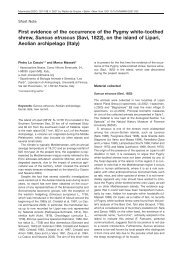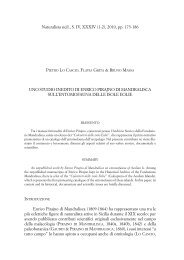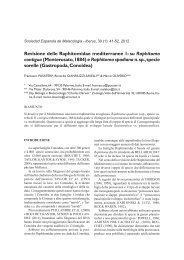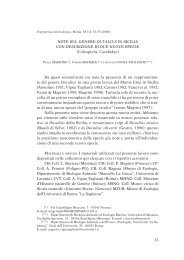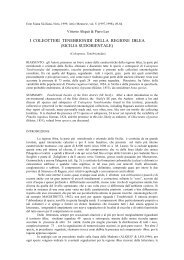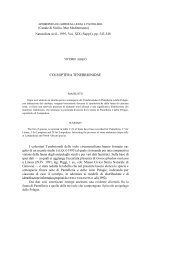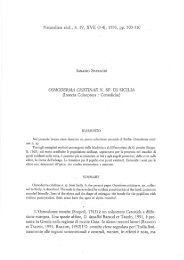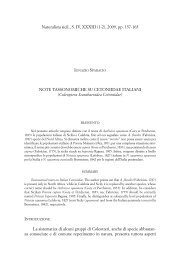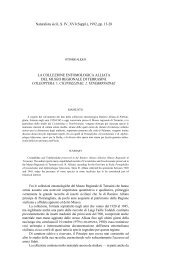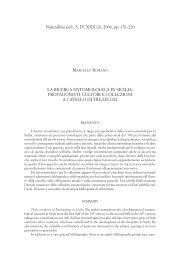Naturalista sicil., S. IV, XXX (3-4), 2006, pp. 537-548 NEW ... - sssn.it
Naturalista sicil., S. IV, XXX (3-4), 2006, pp. 537-548 NEW ... - sssn.it
Naturalista sicil., S. IV, XXX (3-4), 2006, pp. 537-548 NEW ... - sssn.it
- No tags were found...
You also want an ePaper? Increase the reach of your titles
YUMPU automatically turns print PDFs into web optimized ePapers that Google loves.
<strong>Naturalista</strong> <strong>sicil</strong>., S. <strong>IV</strong>, <strong>XXX</strong> (3-4), <strong>2006</strong>, <strong>pp</strong>. <strong>537</strong>-<strong>548</strong>BRUNO MASSA, PAOLO FONTANA & FILIPPO M. BUZZETTI<strong>NEW</strong> SPECIES OF PLATYCLEIS FIEBER, 1853OF THE SUBGENUS DECORANA ZEUNER, 1941IN THE NATURE RESERVE OF TRAPANI SALTPANS(SICILY, ITALY) (Insecta Orthoptera Tettigoniidae)SUMMARYA new species of Platycleis (Decorana) is described from the Trapani saltpans (Sicily), ratherrelated to northafrican species, but easily distinguished from them; the authors point out the precariousnessof the sole population so far known and the importance of <strong>it</strong>s peculiar hab<strong>it</strong>at conservation,actually lying w<strong>it</strong>hin a Nature Reserve and S<strong>it</strong>e of Commun<strong>it</strong>ary Importance.RIASSUNTONuova specie di Platycleis Fieber, 1853 del sottogenere Decorana Zeuner, 1941 nella RiservaNaturale delle Saline di Trapani (Sicilia, Italia) (Orthoptera Tettigoniidae). Gli autori descrivonoPlatycleis (Decorana) drepanensis, specie nuova della Riserva Naturale e S<strong>it</strong>o d’Interesse Comun<strong>it</strong>arioSaline di Trapani, a<strong>pp</strong>artenente ad un sottogenere brach<strong>it</strong>tero in precedenza non noto perl’Italia, ma presente con diverse specie in Nord Africa, penisola Iberica e Medio Oriente. Lanuova specie è affine a P. kabila Finot, 1893 dell’Algeria, ma riconoscibile per i caratteri sessuali ela forma delle tegmine. Nonostante le ricerche intense in tutti gli ambienti salmastri dell’areacostiera del Trapanese, caratterizzati dalla presenza di Chenopodiaceae, la nuova specie risultaattualmente presente in una sola ristretta area, che mer<strong>it</strong>erebbe una particolare attenzione nell’immediatofuturo.On the first week of May <strong>2006</strong> our friends Roy Kleukers, BaudewijnOdé and Luc Willemse collected in the saltpans of Trapani one immaturemale of a Platycleis Fieber, 1853, which reared in the laboratory, resulted tobelong to the subgenus Decorana Zeuner, 1941, h<strong>it</strong>herto unkonwn in Italy.In the following months of July and August, BM, informed by Dutch col-
538 B. MASSA, P. FONTANA & F.M. BUZZETTIleagues of the interesting record, vis<strong>it</strong>ed the same collecting area, finding afair number of males and females, which, after their accurate analysis, resultedto belong to a species previously unknown. We report here <strong>it</strong>s description.Decorana is one of the subgenera established by ZEUNER (1941), which,together w<strong>it</strong>h others, should be considered as a valid genus; nevertheless,now the systematic arrangement still treats <strong>it</strong> as a subgenus of Platycleis andwe follow <strong>it</strong>.MATERIAL AND METHODSSpecimens were collected in May, July and August; dissection of malesconsented to perform t<strong>it</strong>illators examen and to count the egg number w<strong>it</strong>hinthe female abdomen. Stomach analysis consented to establish main feedinghab<strong>it</strong>s. Apart from the collecting local<strong>it</strong>y, BM carried out a carefulresearch on the same hab<strong>it</strong>at along the entire coast from Trapani to Mazaradel Vallo (loc. Capo Feto) in order to find possible other populations of thisspecies.Males were recorded separately in the laboratory to restrict interactionsby FMB and PF. A DAT recorder (Sony TCD 100) w<strong>it</strong>h condenser microphone(Sennheiser K30AV module w<strong>it</strong>h ME80) was used and sampled fragments(44.1 kHz, 16 b<strong>it</strong>s) from the recordings were analysed. The song terminologyfollows RAGGE & REYNOLDS (1998): Calling song (the song producedby an isolated male); Syllable (the sound produced by one complete openingand closing movement of the fore wings); Hemisyllable (the sound producedby one unidirectional movement (opening or closing) of the fore wings);Echeme (a first-order assemblage of syllables).RESULTSPlatycleis (Decorana) drepanensis n. sp.Examined specimens: Trapani Saltpans, loc. Nubia (Nature ReserveSaline di Trapani) 15.V.<strong>2006</strong> (1 ¢, reared in laboratory, paratypus), leg. L.Willemse, R. Kleukers, B. Odé; 18.VII.<strong>2006</strong> (4 ¢¢, 2 , holotypus, allotypusand paratypi); 2.VIII.<strong>2006</strong> (2 ¢¢ paratypi), 10.VIII.<strong>2006</strong> (1 ¢, 2 paratypi), 25.VIII.<strong>2006</strong> (4 ¢¢, 4 paratypi), leg. B. Massa. Holotypus andallotypus depos<strong>it</strong>ed in the Museo Civico di Storia Naturale of Milan, 2paratypi ¢ and in the Museo Civico di Storia Naturale of Genua, 1 paratypus¢ in the coll. L. Willemse, 2 paratypi ¢ and in the coll. P. Fontana (Isola
New species of Platycleis in the Nature Reserve of Trapani saltpans539Vicentina), 2 paratypi ¢ and in the coll. F. M. Buzzetti, 11 paratypi, 7 ¢¢and 4 in the coll. B. Massa (Univers<strong>it</strong>y of Palermo).Diagnosis. It is a Platycleis belonging to the subgenus Decorana characterizedby the shape of the male cerci, the shape of the last male terg<strong>it</strong>e, t<strong>it</strong>illatorsand the shape of subgen<strong>it</strong>al plate of female (Figs 1, 2).Description of the male. Body surface brown and black. Head fromabove brown marbled coloured showing two small black spots between theeyes and the pronotum edge, interrupted by one wh<strong>it</strong>e stripe, pronotumbrown showing a black V on the center and wide black areas on the sides,inferiorly and posteriorly surrounded by a wh<strong>it</strong>e stripe; posterior border ofpronotum rounded (Figs 3a, 3c, 3d). Tegmina roughly reaching the third terg<strong>it</strong>e,brown, second pair of wings atrophic, short about 2/3 of the first one.The stridulatory file (Figs 4f, 4g) is 1.8 mm long and bears 48 pegs of whichthe longest (widest portion of stridulatory file) is 0.1 mm long. Two largeblack bands on the sides of meso and metanotum are evident (Figs 3a, 3c).Legs brown coloured, front and medium femurs bearing a more or less continuousblack line on the u<strong>pp</strong>er border, hind femurs w<strong>it</strong>h a wide lateral blackstripe as long as the broad area of femur, inferiorly edged by reddish-brown,and a fine black stripe on the u<strong>pp</strong>er border (Fig. 3a). Abdomen superiorlygrey, laterally showing a wide brownish-black band, inferiorly yellow. Fronttibiae bearing 3 outer-u<strong>pp</strong>er spines and 5 inner-lower and outer-lower, mediumtibiae w<strong>it</strong>h 6 outer-lower spines and 5-6 inner-lower, 2 outer-u<strong>pp</strong>er and 4inner-u<strong>pp</strong>er, hind tibiae bearing 12 outer-lower spines and 11 inner-lower + 2apical and 30 outer-u<strong>pp</strong>er and 34 inner-u<strong>pp</strong>er + 1 apical.10th terg<strong>it</strong>e pointed, right, ending w<strong>it</strong>h a wide V shaped concav<strong>it</strong>y, characterizedby two black lines from the fore border to the middle of the terg<strong>it</strong>e(Figs 4a, 4e); lateral borders of the V concav<strong>it</strong>y just extruded (Fig. 4e), cercibearing one inner tooth on the apical third, stout and long, brown coloured;tooth evidently forwarded (Figs 4c, 4d). Subgen<strong>it</strong>al plate ending w<strong>it</strong>h a narrowV shaped concav<strong>it</strong>y (Fig. 4b). More or less long hairs characterize thehind border of the last terg<strong>it</strong>es, the V concav<strong>it</strong>y and cerci (Figs 4c, 4d, 4e).Styli narrow, their length is as long or just shorter than cerci (Figs 4a, 4b). T<strong>it</strong>illatorssymmetrical, showing a wide and stout base and a curved and pointedapex, the latter provided by spines (Figs 4h, 4i).Description of the female. Coloration and other characters as those ofthe male (Figs 3b, 3e, 3f), w<strong>it</strong>h the exception of: 9th stern<strong>it</strong>e bearing a smallswelling, subgen<strong>it</strong>al plate ending w<strong>it</strong>h a wide V shaped concav<strong>it</strong>y (Figs 5a,5c), in lateral view short ovipos<strong>it</strong>or brown, evidently upcurved, nearly long asthe hind femurs (Fig. 5b); cerci slender and long. Eggs are pale and measure5.2-5.3 x 0.9-1.0 mm (Fig. 5d).
540 B. MASSA, P. FONTANA & F.M. BUZZETTIFig. 1 — Male of Platycleis (Decorana) drepanensis n. sp. (Photo: F. M. Buzzetti).Fig. 2 — Female of Platycleis (Decorana) drepanensis n. sp. (Photo: B. Massa).
New species of Platycleis in the Nature Reserve of Trapani saltpans541Fig. 3 — Platycleis (Decorana) drepanensisn. sp.; a) male in lateral view; b)female in lateral view; c) head, pronotumand tegmina of male in lateralview; d) head, pronotum and tegminaof male from above; e) head, pronotumand tegmina of female in lateralview; f) head, pronotum and tegminaof female from above (Photo: P.Fontana).Fig. 4 — Platycleis (Decorana)drepanensis n. sp.,characters of the male; a)10 th terg<strong>it</strong>e, cerci and stylifrom above; b) subgen<strong>it</strong>alplate and styli; c) left cercusfrom above; d) left cercusin lateral view; e) 10 thterg<strong>it</strong>e; f) pars stridens; g)tegmina isolated from thebody; h) t<strong>it</strong>illators fromabove; i) t<strong>it</strong>illators frombelow (Photo: P. Fontana).
542 B. MASSA, P. FONTANA & F.M. BUZZETTIFig. 5 — Platycleis (Decorana) drepanensis n. sp., characters of the female; a) subgen<strong>it</strong>al plate frombelow; b) ovipos<strong>it</strong>or and cerci in lateral view; c) 9 th stern<strong>it</strong>e and subgen<strong>it</strong>al plate in lateral view; d)egg (Photo: P. Fontana).Measurements (in mm)Total length from the head to the apex of hind femurs: ¢¢ 29.46 ± 0.74(min = 28.5, max = 30.45); 28.93 ± 1.79 (min = 27.0, max = 31.0); pronotumlength: ¢¢ 5.84 ± 0.13 (min = 5.7, max = 6.0); 5.88 ± 0.50 (min =5.3; max = 6.7); pronotum heigth: ¢¢ 4.46 ± 0.19 (min = 4.3, max = 4.8); 4.6 ± 0.32 (min = 4.3; max = 5.2); length of tegmina: ¢¢ 4.33 ± 0.13 (min= 4.1, max = 4.5); 3.93 ± 0.19 (min = 3.7; max = 4.2); length of hindfemurs: ¢¢ 19.21 ± 0.77 (min = 18.2, max = 20.1); 18.98 ± 1.14 (min =17.2; max = 20.2); heigth of hind femurs: ¢¢ 4.23 ± 0.11 (min = 4.1, max =4.4); 4.05 ± 0.19 (min = 3.9; max = 4.4); ovipos<strong>it</strong>or length: 10.25 ± 0.59(min = 9.5, max = 11.0).There is an ina<strong>pp</strong>reciable size dimorphism, w<strong>it</strong>h males showing longerand higher femurs and longer tegmina than females and females longer andhigher pronotum than males.BioacusticsThe songs of two males were recorded and the song pattern obtainedwas almost identical from them. Due to the bad resolution of one of thesesongs, the detailed description is based on the song of a single male. The callingsong (Fig. 6A-E) of P. (Decorana) drepanensis n. sp. consists of polysyllabicechemes separated by intervals of about 5 seconds and lasts for about 30 seconds.Each echeme (Fig. 6D) has an average length of 264.83 msec (range 234
New species of Platycleis in the Nature Reserve of Trapani saltpans543Fig. 6 — Platycleis (Decorana)drepanensis n. sp.,oscillograms of male callingsong.Fig. 7 — Platycleis (Decorana) drepanensis n. sp., spectrogram of male calling song.
544 B. MASSA, P. FONTANA & F.M. BUZZETTIto 297), <strong>it</strong> consists of one dyplosyllable w<strong>it</strong>h mean length of 90.33 msec (range86 to 95) followed by a series of 5 to 8 microsyllables, each long from 1 to 3msec and repeated at intervals of 25-30 msec. Dyplosyllables are composed ofone longer opening hemisyllable (length 53 msec w<strong>it</strong>h range 50 to 55) plus ashorter and louder closing hemisyllable (length 21.16 msec w<strong>it</strong>h range 18 to23). Echemes can be em<strong>it</strong>ted isolated or followed by series of dyplosyllables(2 to 18) (Fig. 6B). Such repeated dyplosyllables are very similar in length andintens<strong>it</strong>y to echemes starting dyplosyllables and have a repet<strong>it</strong>ion rate of 2 to4 per sec. W<strong>it</strong>hin the recorded interval (up to 25 kHz), frequency shows themain peak at 19 kHz (Fig. 7).Compared w<strong>it</strong>h the song of the only related species of which bioacousticsare known, i. e. Platycleis (Decorana) decorata (Fieber, 1853), asillustrated by HELLER (1988), differences are recognisable in the structure ofthe whole song and of <strong>it</strong>s components. While in P. (Decorana) decorata thecalling song consists of repeated dyplosyllables followed by an echeme composedof one dyplosyllable plus a series of microsyllables, in P. (Decorana)drepanensis n. sp. the order of the em<strong>it</strong>ted components is inverted being theechemes eventually followed by dyplosyllables. Though the echeme groundstructure is rather similar in these two species, the number of microsyllablesin P. (Decorana) drepanensis n. sp. echeme a<strong>pp</strong>ears to be lower than in decorata,being 5-8 vs 9. Furthermore in P. (Decorana) drepanensis n. sp. theecheme microsyllables are much more intense than preceding dyplosyllablewhile in P. (Decorana) decorata are of comparable or lower intens<strong>it</strong>y. Audiblefrequency peack in P. (Decorana) drepanensis is lower (19 kHz) than in P.(Decorana) decorata (20 kHz).Derivatio nominis: this species is named after the Nature Reserve “Salinedi Trapani”, using the adjective drepanensis from Drepanum, the old name ofTrapani c<strong>it</strong>y.Affin<strong>it</strong>iesAccording to ZEUNER (1941), RAMME (1951) and HARZ (1969), thesubgenus Decorana is characterized by the presence of a median keel in thepronotum and by the ovipos<strong>it</strong>or slender, elongate, w<strong>it</strong>h lamella thickened,somewhat downcurved; this consents to tell apart some (but not all) speciesconsidered belonging to the subegenus Incertana Zeuner, 1941, whichshows an ovipos<strong>it</strong>or rather curved upward at the base, similar to that of Tessellana.We compared the new species w<strong>it</strong>h the following three species livingin the western Med<strong>it</strong>erranean, that we consider belonging to the subgenusDecorana.
New species of Platycleis in the Nature Reserve of Trapani saltpans545Platycleis (Decorana) decorata Fieber, 1853Examined specimens: Spain, (Cadiz) Medina Simonia, 10.VII.1976, leg.F. Willemse & J. Scherpbier, 1 ¢ and 1 (coll. PF); Portugal, FoiaMonchigue, 28.VII.1938, Ebner, 1 ¢; Morocco, El Hajeb 22.VII.1932, A.Nadig, 1 ¢ and 1 (Naturistorisches Museum, Vienna).10th terg<strong>it</strong>e of male, in lateral view, short and a l<strong>it</strong>tle downcurved, cercistout and short; from above <strong>it</strong> is evidently larger and less concave than that ofP. drepanensis, w<strong>it</strong>h lateral apexes right; a wide concav<strong>it</strong>y lies in the middle ofthe terg<strong>it</strong>e. Stridulatory file of P. drepanensis bears almost the same numberof pegs than that of P. decorata, being 48 and 46 respectively. T<strong>it</strong>illators morestout and short. The shape of subgen<strong>it</strong>al plate of the female is clearly largerthan that of P. drepanensis, ovipos<strong>it</strong>or is longer than hind femurs. This speciesis distributed over a wide area, from Iberian peninsula to Morocco and showssome variabil<strong>it</strong>y, but characters consenting <strong>it</strong>s identification remain the shapeof 10th terg<strong>it</strong>e and cerci of the male and subgen<strong>it</strong>al plate of female.Platycleis (Decorana) seniae (Finot, 1893)Examined specimens: Algeria, Oran, Brunner, 1 ¢ and 1 ; Bou, 1 (Naturistorisches Museum, Vienna); Oran, 1 ¢ holotypus, 3 ¢¢ and 3 (Museum National d’Histoire Naturelle, Paris).10th terg<strong>it</strong>e of male, in lateral view, short and a l<strong>it</strong>tle downcurved, cercimuch stout, a l<strong>it</strong>tle upcurved and innercurved, styli shorter than those of P.drepanensis; from above <strong>it</strong> is very narrow and protruded and shows a wide concav<strong>it</strong>yin <strong>it</strong>s middle; t<strong>it</strong>illators are very stout and short in respect to those of P.drepanensis. Female subgen<strong>it</strong>al plate is very large, even if variable, in lateral view<strong>it</strong> is evidently longer than that of P. drepanensis; female cerci are more stout thanthose of P. drepanensis. Ovipos<strong>it</strong>or is clearly shorter than hind femurs.Platycleis (Decorana) kabila (Finot, 1893)Examined specimens: Algeria, Chabet el Ameur, 1 ¢, Finot (holotypus)(Museum National d’Histoire Naturelle, Paris).Only the type male is known of this species. Its 10th terg<strong>it</strong>e on lateralview is downcurved and shorter than that of P. drepanensis, cerci are a l<strong>it</strong>tleupcurved, w<strong>it</strong>h inner tooth clearly upcurved, styli longer than cerci; fromabove <strong>it</strong> shows a small blackish concav<strong>it</strong>y ending w<strong>it</strong>h a narrower V than P.drepanensis. Tegmina a l<strong>it</strong>tle longer (5.1 mm) than those of P. drepanensis.Biological notesP. drepanensis resulted active during the day, less in the hottest hours,when <strong>it</strong> prefers to hide himself inside the soil crevices and w<strong>it</strong>hin the vegetation;during the first hours of the day (between 8:00 and 11:00), when the sun
546 B. MASSA, P. FONTANA & F.M. BUZZETTIbegins to heat the vegetation, <strong>it</strong> may go out from <strong>it</strong>, remaining over the plants,unless disturbed. Stomach analysis revealed the presence of vegetal residuals,mainly const<strong>it</strong>uted by Chenopodiaceae; only one specimen contained remnantsof small Hemiptera nymphs. Thus, we may consider <strong>it</strong> a herbivorousspecies which could predate some insects. Abdomen of females collected on18th July and 10th August did not contain eggs, while those collected on 25thAugust had a number variable of eggs, between 12 and 55. According to ourdata, phenology of P. drepanensis is summer-autumnal and possibly, as other<strong>sicil</strong>ian Tettigoniidae, eggs overwinter, neanids hatch in spring and develop inearly summer.IMPORTANCE OF HALOPHYTIC HABITATS OF TRAPANI COASTDuring the researches carried out in July-August <strong>2006</strong> between the saltpansof Trapani and the salty marshes of Capo Feto (Mazara del Vallo) almostall the hab<strong>it</strong>ats considered su<strong>it</strong>able to this species were unfru<strong>it</strong>fully vis<strong>it</strong>ed tosearch for <strong>it</strong>s presence; actually, the sole known population seems to be thatfound in a small area w<strong>it</strong>hin the Trapani saltpans, not wider than 500 m 2 ; thehab<strong>it</strong>at to which the species is linked is dominated by a vegetation ofChenopodiaceae, mainly const<strong>it</strong>uted by Arthrocnemum glaucum. W<strong>it</strong>hin thearea inhab<strong>it</strong>ed by P. drepanensis other three interesting species have beenfound: Platycleis (Tessellana) tessellata (Charpentier, 1825) (a short-wingedform), Pterolepis elymica Galvagni & Massa, 1980 (endemic to Trapani coast)and Platypigius platypigius (Pantel, 1886) (in Italy known only for Sardiniaand Sicily, previously unknown for Trapani saltpans); researches in other similarhab<strong>it</strong>ats, dominated by Chenopodiaceae, from Trapani to Mazara delVallo consented to find, other than the species above listed, also another twointeresting taxa, namely Ctenodecticus siculus Ramme, 1927 (endemic to Sicily,where few populations are currently known) and Heteracris adspersa(Redtenbacher, 1889) (so far recorded in Sicily only from Gela and named assubspecies massai Galvagni, 1978).As regards insects belonging to other orders, halophytic hab<strong>it</strong>ats of Trapanisaltpans are inhab<strong>it</strong>ed by four species of Heteroptera Miridae linked toChenopodiaceae (Phytocoris salsolae (Puton, 1875), Orthotylus divisus Linnavuori,1961, O. roseiceps Wagner, 1968 and O. curvipennis Reuter, 1875),one Lepidoptera Lymantriidae (Orgya dubia arcerii Ragusa, 1923) (endemicto Trapani coast), three Coleoptera Carabidae (Cephalota l<strong>it</strong>orea goudoti(Dejean, 1829), Cephalota circumdata imperialis (Klug, 1834) and Cassolaiamaura cupreothoracica Korell & Cassola, 1987) very local and endangered(ROMANO et al., <strong>2006</strong>).
New species of Platycleis in the Nature Reserve of Trapani saltpans547We believe that the only characteristic distinguishing the area inhab<strong>it</strong>edby P. drepanensis from other halophytic hab<strong>it</strong>ats of Trapani coast is <strong>it</strong>s highdryness and scarce moistness (Fig. 8). Nonetheless, the area where P. drepanensishas been found lies w<strong>it</strong>hin the Nature Reserve “Saline di Trapani e Paceco”,established by the Regione Siciliana on 1995 and managed by the WorldFig. 8 — Hab<strong>it</strong>at of Trapani saltpans Nature Reserve, where Platycleis (Decorana) drepanensis n. sp. hasbeen found, characterized by Arthrocnemum glaucum and other Chenopodiaceae (Photo: B. Massa).Wildlife Fund, and, according to Hab<strong>it</strong>at Directive 92/43/CEE and BirdsDirective 409/79/CEE, w<strong>it</strong>hin the S<strong>it</strong>e of Commun<strong>it</strong>y Importance and SpecialProtection Area ITA010007 “Saline di Trapani” (defin<strong>it</strong>ively established on 19July <strong>2006</strong> by Commission deliberation <strong>2006</strong>/613/CE), characterized by thepresence of the following costal and halophytic hab<strong>it</strong>at included in the A<strong>pp</strong>endixI of Hab<strong>it</strong>at Directive: Med<strong>it</strong>erranean and thermo-Atlantic salt marshesand salt meadows (Sarcocornetea fruticosi). This should guarantee <strong>it</strong>s futureconservation and possible actions to manage pos<strong>it</strong>ively <strong>it</strong>; <strong>it</strong> is noteworthy thatthe Reserve manager author<strong>it</strong>y (WWF) identified the area inhab<strong>it</strong>ed by the
<strong>548</strong> B. MASSA, P. FONTANA & F.M. BUZZETTInew Platycleis w<strong>it</strong>hin those deserving special protection, proposing <strong>it</strong>s acquis<strong>it</strong>ionand ecological restoration, which are in progress by Azienda ForesteDemaniali Regione Siciliana (Sicilian Forestry Body), w<strong>it</strong>hin the Piano OperativoRegionale (Regional Operational Plane) of Sicily 2000-<strong>2006</strong>. Futureactions could improve the demography of <strong>it</strong>s small population.Acknowledgements — The first specimen of this species has been collected by Roy Kleukers,Baudewijn Odé and Luc Willemse during a naturalistic vis<strong>it</strong> to Sicily; we thank them very much forhaving shared w<strong>it</strong>h us this unexpected record. We also thank very much Angelo Troìa, director ofthe Nature Reserve “Saline di Trapani e Paceco”, managed by the World Wildlife Fund, who authorizedus to collect some specimens of the new species and kindly collaborated to the research on thesaltpans. Specimens preserved at the Naturistorisches Museum, Vienna, and at the Museum Nationald’Histoire Naturelle, Paris, have been examined during two study stay funded by the Univers<strong>it</strong>àdegli Studi di Palermo. This paper has been carried out by M.U.R.S.T. (ex 60%) funds (responsible:B.M.).REFERENCESHARZ K., 1969 — Die Orthopteren Europas, 1. — Junk B. V., The Hague, 749 <strong>pp</strong>.HELLER K.G., 1988 — Bioakustik der europäischen Laubheuschrecken. — Ökologie in Forschungund Anwendung, 1: 1-358.RAGGE D.R. & REYNOLDS W.J., 1998 — The songs of the Grassho<strong>pp</strong>ers and Crickets of WesternEurope. — Harley Books, Colchester, 591 <strong>pp</strong>.RAMME W., 1951 — Zur Systematik Faunistik und Biologie der Orthopteren von südost-Europa undVorderasien. — M<strong>it</strong>t. Zool. Mus. Berlin, 27: 1-431, 29 pl.ROMANO M., SPARACIO I. & MASSA B., <strong>2006</strong> — Gli Insetti delle Saline di Trapani. Pp. 123-131 in:Troìa A. (ed.), Saline di Trapani e Paceco. Guida alla storia naturale. — Ed. Anteprima,Palermo.ZEUNER F. E. 1941 — The classification of the Decticinae h<strong>it</strong>herto included in Platycleis Fieb. orMetrioptera Wesm. (Orthoptera, Saltatoria). — Trans. R. ent. Soc. London, 91: 1-50.Authors’ address — B. MASSA, Dipartimento SEMFIMIZO (Entomologia, Acarologia,Zoologia), Univers<strong>it</strong>à di Palermo, Viale delle Scienze, 13 - 90128 Palermo (I); e-mail:zoola<strong>pp</strong>l@unipa.<strong>it</strong>; P. FONTANA, F.M. BUZZETTI, Dipartimento Agronomia Ambientale e ProduzioniVegetali (Entomologia), Univers<strong>it</strong>à di Padova, AGRIPOLIS, Viale dell’Univers<strong>it</strong>à, 16 -35020 Legnaro (Padova) (I); e-mail: paolo.fontana@unipd.<strong>it</strong>



